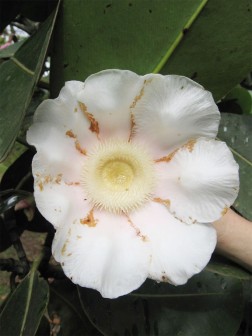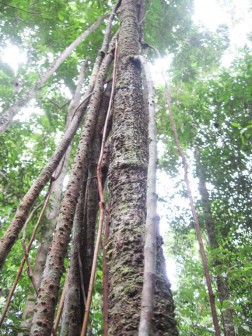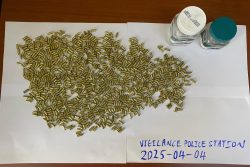Kufa (Clusiaspp) is a plant which is widely distributed in the tropical rainforests of Guyana and belongs to the family of plants known as Clusiaceae. The seeds of Kufa germinate in the upper most branches of the biggest trees in the canopy of the rain forest.
As the Kufa plant grows it begins to send down roots (aerial roots) to the forest floor for nutrients and water. As a result of this behaviour Kufa is classified as a hemi-epiphytic plant, and in some instances it can kill the host tree it grows on by strangulation!
The Kufa plant when cut gives off translucent, white, cream or orange-yellow latex. The plant has large pinkish white flowers which have a sticky yellow substance in the centre.
![]() When Kufa is in bloom, the forest floor at the base of its host tree is usually covered with flowers. Once fertilisation of the flowers occurs, a fruit capsule develops. This dehiscent fruit (opens when ripe) usually has several chambers containing many seeds which are covered with a yellow or orange-red fleshy layer(aril). These seeds are eaten by many birds and carried far from the parent plant and dispersed throughout the forest.
When Kufa is in bloom, the forest floor at the base of its host tree is usually covered with flowers. Once fertilisation of the flowers occurs, a fruit capsule develops. This dehiscent fruit (opens when ripe) usually has several chambers containing many seeds which are covered with a yellow or orange-red fleshy layer(aril). These seeds are eaten by many birds and carried far from the parent plant and dispersed throughout the forest.

The aerial roots of Kufa are pliable with very strong fibres making it an important non-timber forest product (NTFP). These thick, woody roots are used for the framing of chairs, benches and tables for the manufacture of wicker furniture in Guyana. If less than half of the roots are harvested it will not kill the plant, allowing multiple roots to be collected from the same plant over many years.
The latex or gum from the stems and aerial roots of the Kufa is also collected by Amerindians to prepare a wax known as ‘Karaman’. This wax is used for caulking boats and canoes, in addition to being used as a general adhesive paste.
The main areas of commercial harvesting and processing of Kufa is the Moruca area and along the Pomeroon River in Guyana. At present the Guyana Forestry Commission is developing a code of practice for the sustainable harvesting of Kufa to protect the jobs of the large number of people involved in Kufa harvesting and the associated wicker furniture industry.
http://www.iwokrama.org.

Rain forests are rich in biodiversity and are home to many different plants and animals. In addition, indigenous communities make their homes there. Even if you don’t live in the rain forest, humans rely on the forest for resources such as building materials (wood and lianas), medicine and fruits. Rain forests also provide essential environmental services for life on earth; they create soil as well as prevent soil erosion, produce oxygen though photosynthesis, maintain clean water systems, and are a key defence against climate change.
The Iwokrama Rain Forest is 371,000 hectares, located in the heart of Guyana. Our mission is to develop strategies for conservation and sustainable development for local people in Guyana and the world at large. We are involved in tourism, training, research and our timber is certified by the Forest Stewardship Council. Come and visit us in the rain forest or at








